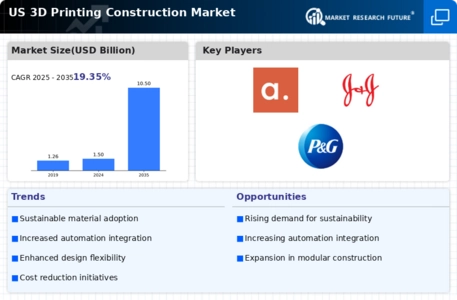Cost Efficiency
Cost efficiency emerges as a significant driver within the Global US 3D Printing Construction Market Industry. The ability to reduce labor costs and material waste through automated processes makes 3D printing an attractive option for developers and contractors. For instance, projects that leverage 3D printing technology can achieve savings of up to 30% in overall construction costs. This financial incentive is particularly appealing in a competitive market where profit margins are often tight. As the technology matures and becomes more widely adopted, the cost advantages are expected to further stimulate market growth, contributing to the anticipated increase from 1.5 USD Billion in 2024 to 10.5 USD Billion by 2035.
Market Growth Projections
The Global US 3D Printing Construction Market Industry is poised for substantial growth, with projections indicating an increase from 1.5 USD Billion in 2024 to 10.5 USD Billion by 2035. This growth trajectory reflects a compound annual growth rate (CAGR) of 19.35% from 2025 to 2035. Such figures underscore the increasing adoption of 3D printing technologies across various construction applications, including residential, commercial, and infrastructure projects. The anticipated expansion is likely to attract investments and foster innovation within the sector, further solidifying the role of 3D printing as a transformative force in the construction industry.
Sustainability Initiatives
Sustainability initiatives play a crucial role in driving the Global US 3D Printing Construction Market Industry. As environmental concerns escalate, the construction sector is increasingly seeking eco-friendly alternatives to traditional building methods. 3D printing offers the potential to minimize waste and reduce carbon footprints through the use of recyclable materials and efficient construction processes. For example, projects utilizing 3D printing have demonstrated a reduction in material waste by up to 60% compared to conventional methods. This alignment with sustainability goals not only appeals to environmentally conscious consumers but also positions the industry favorably in a market that is projected to grow at a CAGR of 19.35% from 2025 to 2035.
Technological Advancements
The Global US 3D Printing Construction Market Industry is propelled by rapid technological advancements in 3D printing materials and methods. Innovations such as the development of high-performance concrete and bio-based materials enhance the durability and sustainability of printed structures. For instance, the introduction of large-scale printers capable of producing entire homes in a matter of days exemplifies this trend. As these technologies evolve, they are expected to reduce construction costs and timeframes significantly, thereby attracting more stakeholders to the market. This shift is likely to contribute to the projected market growth from 1.5 USD Billion in 2024 to an estimated 10.5 USD Billion by 2035.
Urbanization and Housing Demand
Urbanization and the increasing demand for affordable housing serve as critical drivers for the Global US 3D Printing Construction Market Industry. As urban populations continue to swell, the need for efficient and cost-effective housing solutions becomes paramount. 3D printing technology offers a viable solution by enabling rapid construction of homes that meet the growing demand. For instance, projects in urban areas have successfully utilized 3D printing to deliver affordable housing units in record time. This trend is expected to gain momentum, particularly as the market is projected to expand from 1.5 USD Billion in 2024 to 10.5 USD Billion by 2035, driven by the need for innovative housing solutions.
Government Support and Regulations
Government support and favorable regulations significantly influence the Global US 3D Printing Construction Market Industry. Various federal and state initiatives aim to promote innovative construction technologies, including 3D printing. For example, grants and funding programs are available to encourage research and development in this field. Additionally, regulatory frameworks are evolving to accommodate the unique aspects of 3D printed structures, facilitating their acceptance in the mainstream construction market. This supportive environment is likely to enhance investor confidence and encourage the adoption of 3D printing technologies, thereby contributing to the projected market growth trajectory.














Leave a Comment